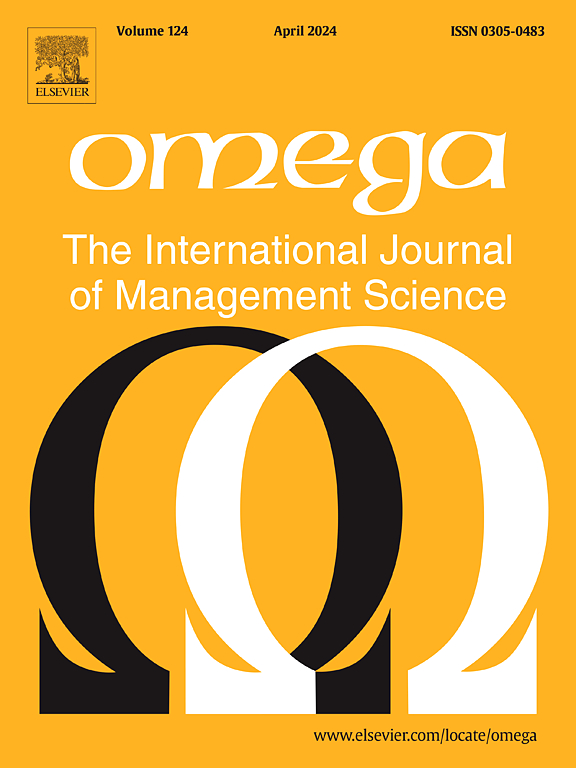揭示众筹的新功能:生产风险转移机制
IF 7.2
2区 管理学
Q1 MANAGEMENT
Omega-international Journal of Management Science
Pub Date : 2025-09-11
DOI:10.1016/j.omega.2025.103408
引用次数: 0
摘要
现有文献强调了众筹固有的融资优势,往往忽视了其关键的风险转移功能。通过考虑损失规避因素,我们构建了一个综合的众筹模型,以区分众筹与传统融资模式在降低生产风险方面的差异。在传统的融资模式中,企业家通过在个人资金和贷款资金之间合理分配资产负债组合,在融资成本和生产风险之间进行战略权衡。相反,众筹模式需要企业家预售产品,从而将买家定位为风险的承担者。我们的研究结果表明,众筹并没有普遍成为主导策略。在生产成本较高、产品价值较低的情况下,建议创业者利用众筹来减少融资费用,降低需求的不确定性。然而,这需要将生产风险转移给买家,迫使企业家设定更适度的产品价格。当生产成本较低或产品价值较高时,传统的融资模式比众筹更有优势。引入众筹会导致买家的支付意愿急剧下降,边际收益也会受到毫无根据的侵蚀。这就解释了为什么在众筹平台上发布的产品往往缺乏实质性的价值。此外,我们引入了延期支付机制,以提高众筹效率,并揭示了其在风险分担中的作用。我们还详细分析了资本约束、产品属性、风险和市场规模对最优提前还款率的影响。最后,我们探讨了五个有趣的扩展:异质买家估值、市场规模遵循均匀分布、混合融资、质量内生性和众筹市场的部分消费者,得出了有价值的见解。本文章由计算机程序翻译,如有差异,请以英文原文为准。
Reveal the new function of crowdfunding: Production risk transfer mechanism
Existing literature has underscored the financing advantages intrinsic to crowdfunding, often overlooking its pivotal risk transfer function. By factoring in elements of loss aversion, our study formulates a comprehensive crowdfunding model to discern disparities between the crowdfunding and traditional financing model in mitigating the production risk. In the traditional financing model, the entrepreneur navigates a strategic trade-off between the financing cost and production risk by judiciously allocating the asset–liability portfolio between personal funds and loan capital. Conversely, the crowdfunding model entails the entrepreneur pre-selling the products, thereby positioning buyers as the bearer of risk. Our results indicate that crowdfunding does not universally emerge as the dominant strategy. When the production cost is high and product value is low, the entrepreneur is advised to leverage crowdfunding to curtail financing expenses and mitigate demand uncertainty. This, however, entails transferring the production risk to buyers, necessitating the entrepreneur to set a more modest product price. When the production cost is low or the product value is high, the traditional financing model outshines crowdfunding. Introducing crowdfunding will trigger a precipitous decline in buyers’ willingness to pay and an unwarranted erosion of marginal returns. This elucidates why products unveiled on crowdfunding platforms frequently exhibit a lack of substantial value. Additionally, we introduce the deferred payment mechanism to augment crowdfunding efficacy and unveil its role in risk sharing. We also analyze in detail how the optimal prepayment ratio is affected by capital constraints, product attributes, risks, and market size. Finally, we explore five intriguing extensions: heterogeneous buyer valuations, the market size follows uniform distribution, hybrid financing, quality endogeneity, and partial consumers in crowdfunding market, yielding valuable insights.
求助全文
通过发布文献求助,成功后即可免费获取论文全文。
去求助
来源期刊

Omega-international Journal of Management Science
管理科学-运筹学与管理科学
CiteScore
13.80
自引率
11.60%
发文量
130
审稿时长
56 days
期刊介绍:
Omega reports on developments in management, including the latest research results and applications. Original contributions and review articles describe the state of the art in specific fields or functions of management, while there are shorter critical assessments of particular management techniques. Other features of the journal are the "Memoranda" section for short communications and "Feedback", a correspondence column. Omega is both stimulating reading and an important source for practising managers, specialists in management services, operational research workers and management scientists, management consultants, academics, students and research personnel throughout the world. The material published is of high quality and relevance, written in a manner which makes it accessible to all of this wide-ranging readership. Preference will be given to papers with implications to the practice of management. Submissions of purely theoretical papers are discouraged. The review of material for publication in the journal reflects this aim.
 求助内容:
求助内容: 应助结果提醒方式:
应助结果提醒方式:


